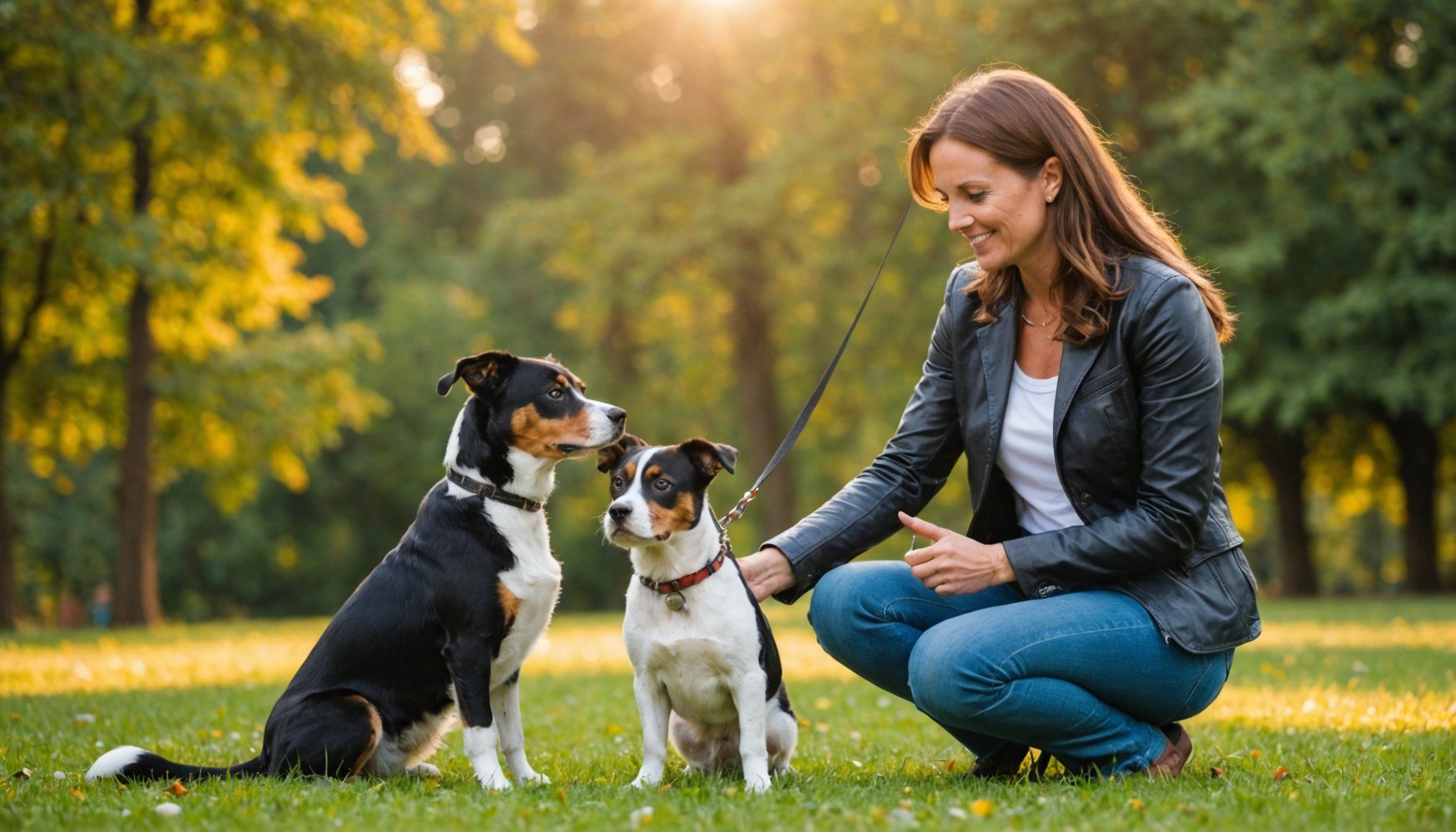Understanding the Basics of Pet Training
Establishing a solid foundation in pet training fundamentals is crucial for effective communication with your pet. At the heart of successful training lies a keen understanding of positive reinforcement, which rewards desired behaviors, thus encouraging pets to repeat them. This method leverages treats, praise, or affection, proving to be a powerful motivator. Unlike punishment-based tactics, positive reinforcement builds trust and nurtures positive pet behavior.
Several training methods cater to different learning styles and needs. These include clicker training, shaping, and luring, each offering unique benefits. Clicker training, for example, involves using a distinct sound to mark and reward desired behaviors, enhancing the learning process. Shaping gradually guides animals toward complex behaviors, while luring employs treats to lead pets through actions.
In the same genre : Nourishing Your Pets: Tips to Keep Them Healthy and Ahead of the Curve
For pet owners, understanding these methods’ effectiveness is vital. Employing positive reinforcement not only fosters a healthy bond but also alleviates common training challenges. Thus, integrating these pet training fundamentals into daily routines cultivates an enriching learning environment. Embracing a rewards-based approach ensures pets are encouraged, motivated, and eager to learn, ultimately leading to a well-trained, happy companion.
Age-Specific Training Techniques
Tailoring training techniques to a pet’s age is essential for a successful learning experience. Puppy training establishes the foundation of life skills and socialization, which are crucial during this developmental stage. Introducing basic commands and familiarizing puppies with diverse environments can significantly impact their adaptability and behavior.
In the same genre : Essential Pet Diets: Key Nutritional Plans You Must Discover
For adult dogs, maintaining motivation is key. Adult dogs can still learn new tricks and behaviors, though it might require different strategies than those used with puppies. Focusing on specific needs, such as enrichment and reinforcing past training, ensures consistent obedience and engagement.
When training senior pets, patience and adjustments to accommodate mobility or sensory limitations are critical. Senior pets may not learn at the same pace as younger ones but are still capable of grasping new concepts and adapting to changes. Tailoring older pets’ training respects their limitations while enhancing cognitive engagement and maintaining a quality bond with their owners.
Understanding these age-specific techniques allows for a seamless training process. By recognizing the unique needs and corresponding strategies of each age group, training becomes a rewarding experience for pet and owner alike.
Addressing Common Training Challenges
Training pets often presents behavior issues that demand attention. Identifying and addressing these challenges early is crucial for effective behavior modification. For instance, if a dog exhibits excessive barking, it’s essential to understand the trigger points before applying a correction technique.
Common training obstacles include lack of consistency, unclear commands, and ineffective timing during reinforcement. Overcoming these requires a systematic approach. Breaking down complex commands into simpler steps can improve clarity and engagement. Similarly, consistent application of training methods, such as establishing a routine, can facilitate better learning.
Pet owners frequently face challenges in maintaining patience and managing personal frustrations during training. It’s normal to feel overwhelmed, particularly when progress seems slow. However, employing strategies like setting small, achievable goals can help mitigate stress. Regularly reflecting on improvements, no matter how minor, can renew motivation and commitment.
Ultimately, recognizing potential training hurdles and implementing targeted solutions empowers pet owners to navigate the training process more effectively. Thus, fostering a nurturing environment that supports both the pet and the owner during their shared learning journey.
Insights into Positive Reinforcement Strategies
In rewards-based training, the key is employing the right types of rewards to motivate pets effectively. Rewards can include treats, verbal praise, or playtime, aligning with an animal’s preferences and enhancing their learning experience. Implementing these rewards immediately after a desired behavior reinforces the connection between action and reward, promoting consistent pet behavior.
Differentiating between intrinsic and extrinsic motivation is crucial for understanding your pet’s responses. Intrinsic motivation involves behaviors performed for personal satisfaction, such as a dog sitting without prompts due to comfort. Extrinsic motivation, on the other hand, relies on external rewards like treats to encourage behaviors. Striking a balance between these motivations can foster long-term behavioral success.
Real-life examples illustrate the power of positive reinforcement. For instance, many pet owners have observed their pets mastering tasks like “sit” or “stay” when trained with consistent rewards. One dog managed to overcome reactivity through personalized and motivating reward strategies. These anecdotes emphasize the effectiveness of positive reinforcement, proving that tailoring motivation to individual pets yields rewarding results for both pet and owner. Adopting rewards-based techniques nurtures a willing, engaged learner ready to embrace new challenges.
Techniques for Effective Behavioral Modification
Behavioural modification is a structured approach to altering a pet’s undesirable actions. Understanding the process begins with identifying the root cause of the unwanted behaviour, such as fear, anxiety, or mere lack of training. Implementing correction techniques involves guiding pets towards desired behaviours using non-punitive strategies, such as redirection or ignoring undesirable actions.
Ethical considerations in training are paramount. Using negative reinforcements or punishments can harm the pet’s mental wellbeing and the trust shared with its owner. Instead, positive, solution-oriented methods foster a healthy learning environment and strong bond.
Pet owners often report training success stories that highlight the transformative potential of behavioural modification. For instance, a once-aggressive dog can learn gentle behaviour through patience and consistent positive reinforcement. Similarly, many cats with scratching issues adapt to using scratching posts solely by substituting behaviours without penalties.
The shared experiences of pet owners underscore the power of ethical and conscientious behaviour modification. With dedication to humane methods, pets not only adapt but thrive, leading to improved behaviour and closer relationships with their humans.
Utilizing Visual Aids in Training
Employing visual aids as training tools can significantly enhance a pet’s learning experience. Visual prompts, such as gesture commands or target sticks, offer clear signals that aid in understanding expected behaviors. Incorporating visual prompts can therefore serve as an effective complement to auditory cues and physical gestures.
Effective use of visual aids involves aligning these prompts with the pet’s existing comprehension levels. By introducing visual signals gradually, pets can relate them directly to specific actions or rewards. Such tools are especially beneficial for engagement strategies with hearing-impaired pets, as they rely more heavily on sight for communication.
Pet owners have developed creative solutions for utilizing visual prompts. For example, using colors to signify different commands or installing visual markers within a training environment enhances a pet’s ability to navigate tasks. These aids are not exclusive to dogs; many cat owners successfully use light pointers to establish boundaries or designate play areas.
Transitioning to visual aids reflects a broader adaptability in training methods. By tapping into a pet’s capacity to respond to diverse stimuli, trainers can foster an enriching learning experience. This approach ensures pets remain engaged, motivated, and ready to explore new skills.
Building Consistency and Routine in Training
Creating a consistent training routine is fundamental to reinforcing learned behaviors. Pets thrive on regularity; it helps solidify commands and actions, fostering dependable responses. To this end, establishing scheduled training times supports their understanding of expectations. This predictability can greatly enhance the pet’s learning experience, making them more adaptable and responsive.
Establishing consistency across training sessions requires deliberate effort. Maintaining a standard approach for executing commands and using the same cues each time ensures clarity. Altering rewards, tones, or commands can confuse pets, hindering their progress. By aligning all household members on these practices, consistency becomes more achievable.
Anecdotal evidence shows that pet owners who prioritized routine building reported significant improvements in their pet’s learning habits and overall behavior. Pets understand and anticipate training sessions when they occur at regular intervals, enhancing cooperation and enthusiasm. Consistency not only develops competence in responding to commands but also fosters a stronger bond between the pet and owner.
To successfully build routines and training consistency, pet owners should focus on creating a positive environment where pets can engage confidently in their training journey, promoting sustained learning and successful behavior reinforcement.











